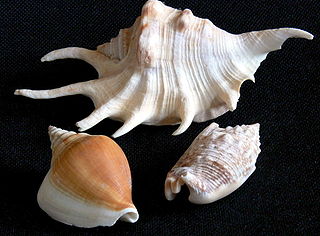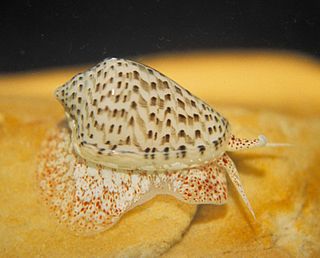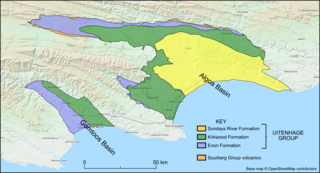
Strombidae, commonly known as the true conchs, is a taxonomic family of medium-sized to very large sea snails in the superfamily Stromboidea. The term true conchs, being a common name, does not have an exact meaning. It may refer generally to any of the Strombidae but sometimes is used more specifically to include only Strombus and Lambis. The family currently includes 23 extant, and 10 extinct genera.

Littorinimorpha is a large order of snails, gastropods, consisting primarily of sea snails, but also including some freshwater snails and land snails.
The Albian is both an age of the geologic timescale and a stage in the stratigraphic column. It is the youngest or uppermost subdivision of the Early/Lower Cretaceous epoch/series. Its approximate time range is 113.0 ± 1.0 Ma to 100.5 ± 0.9 Ma. The Albian is preceded by the Aptian and followed by the Cenomanian.
In the geologic timescale, the Callovian is an age and stage in the Middle Jurassic, lasting between 166.1 ± 4.0 Ma and 163.5 ± 4.0 Ma. It is the last stage of the Middle Jurassic, following the Bathonian and preceding the Oxfordian.

Machimosaurus is an extinct genus of machimosaurid crocodyliform from the Late Jurassic and Early Cretaceous. The type species, Machimosaurus hugii, was found in Switzerland. Other fossils have been found in England, France, Germany, Portugal, Switzerland and Tunisia. Machimosaurus rex is the largest named teleosauroid and thalattosuchian, with an estimated length of approximately 7.2 metres. Machimosaurus is the largest known crocodyliform of the Jurassic.

Marginellidae, or the margin shells, are a taxonomic family of small, often colorful, sea snails, marine gastropod molluscs in the clade Neogastropoda.

Cyclophoridae is a taxonomic family of small to large tropical land snails with an operculum, terrestrial gastropod mollusks in the informal group Architaenioglossa belonging to the clade Caenogastropoda.
Paleontology or palaeontology is the study of prehistoric life forms on Earth through the examination of plant and animal fossils. This includes the study of body fossils, tracks (ichnites), burrows, cast-off parts, fossilised feces (coprolites), palynomorphs and chemical residues. Because humans have encountered fossils for millennia, paleontology has a long history both before and after becoming formalized as a science. This article records significant discoveries and events related to paleontology that occurred or were published in the year 1994.

Penion is a genus of large marine snails, commonly known as siphon whelks, classified within the mollusc family Buccinidae, the true whelks.

Palaeocoma d'Orbigny, 1850, is an extinct genus of brittle stars that lived during the Middle Triassic to Early Jurassic Periods. Its fossils have been found in Europe.

Hybodontiformes, also called hybodonts, are an extinct subset of Elasmobranchii which existed from the late Devonian to the Late Cretaceous. They form the group of sharks closest to neoselachians, the clade of modern sharks and rays. Hybodonts were named and are distinguished based on their conical tooth shape. They comprised the main group of Jurassic sharks in Europe and North America. They survived into the Late Cretaceous before going extinct, possibly due to competition from other sharks. Lonchidion was one of the last hybodonts — its distinctive serrated fine spines occur in freshwater deposits from Wyoming alongside the fossils of the last dinosaurs, including Tyrannosaurus rex and Triceratops. Hybodontiformes are identified in the fossil record predominantly based on distinct teeth and fin spines. They were known to live in both fresh and salt water environments.

Aporrhaidae is a family of sea snails commonly called the "pelican's foot snails." The taxonomy of the Gastropoda by Bouchet & Rocroi, 2005 categorizes Aporrhaidae as marine gastropod mollusks in the clade Littorinimorpha.

Somalirhynchia africana is a species of extinct, medium-sized brachiopod, a marine rhynchonellate lampshell in the family Tetrarhynchiidae. It is roughly the size and shape of a 1-inch (25 mm) toy marble, and has about 29 ribs fanning out from the hinge.
This list, 2014 in molluscan paleontology, is a list of new taxa of ammonites and other fossil cephalopods, as well as fossil gastropods, bivalves and other molluscs that have been described during the year 2014.

Harpagodes is an extinct genus of fossil sea snails, marine gastropod mollusks in the family Harpagodidae.

Eucithara crystallina is a small sea snail, a marine gastropod mollusk in the family Mangeliidae.
Mangelia colombi is a species of sea snail, a marine gastropod mollusk in the family Mangeliidae.

The Uitenhage Group is one of three geological groups, which comprise the onshore and offshore post-Karoo middle to lower Upper Mesozoic geological rock units in South Africa. Stratigraphically, the Uitenhage Group overlies the Suurberg Group and is overlain by the Algoa Group. It contains four formations that range in age from late Early Jurassic and late Early Cretaceous in age.

Eocithara is an extinct genus of sea snails, marine gastropod mollusks, in the family Harpidae.

Hemilienardia malleti is a species of sea snail, a marine gastropod mollusk in the family Raphitomidae.















